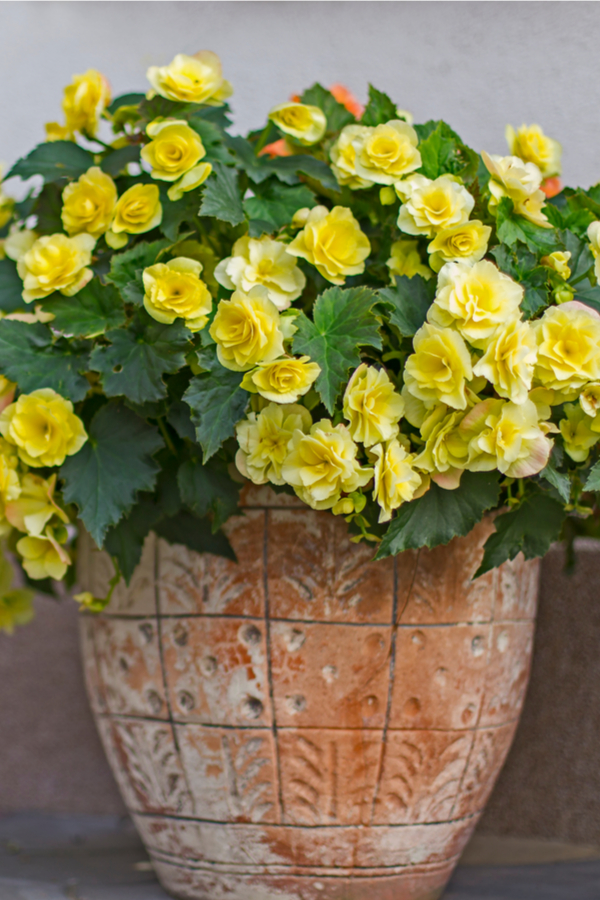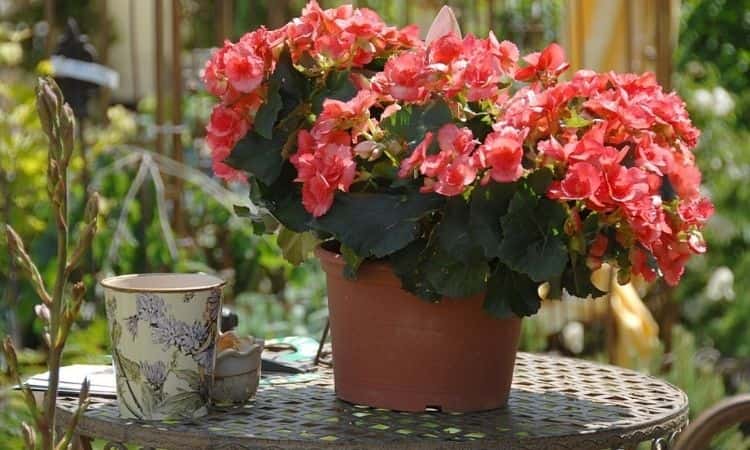Choosing the Right Pot for Your Begonia
Selecting the right pot is a crucial aspect of the care of begonias in pots. A pot that provides good drainage, aeration, and room for growth is essential for healthy development and thriving begonias. When choosing a pot, consider the material, size, and shape to ensure optimal growth. Unglazed clay pots or those with built-in drainage holes are ideal for begonias, as they allow for excess water to escape and prevent waterlogged soil. Avoid using plastic or ceramic pots without drainage holes, as they can lead to root rot and other problems. In terms of size, choose a pot that is at least 1-2 sizes larger than the begonia’s current pot. This will give the roots room to grow and expand, promoting healthy development. The shape of the pot is also important, with rounded or oval shapes providing more room for growth than square or rectangular shapes. By selecting the right pot, you’ll be providing your begonia with a solid foundation for growth and development. Remember, a good pot is just the starting point for successful care of begonias in pots – stay tuned for more tips on soil, watering, and fertilizing your begonia.
Soil Secrets: The Perfect Mix for Begonias in Containers
When it comes to the care of begonias in pots, the right potting mix is crucial for healthy growth and development. A well-draining potting mix specifically designed for begonias is essential to prevent waterlogged soil and root rot. To create the perfect mix, consider the importance of pH levels, nutrient balance, and organic matter. Begonias thrive in slightly acidic to neutral soil pH, ranging from 6.0 to 7.0. A balanced fertilizer with equal ratios of nitrogen, phosphorus, and potassium provides the necessary nutrients for healthy growth. Organic matter such as peat moss, compost, or perlite improves soil structure, increases water retention, and provides a slow release of nutrients. A mix with a combination of these ingredients will provide the ideal environment for your begonia’s roots to grow and thrive. Some popular potting mixes for begonias include a mix of peat moss, vermiculite, and perlite, or a combination of compost, bark chips, and coconut coir. Avoid using regular garden soil, as it can compact and prevent proper drainage in pots. By creating a well-draining potting mix specifically designed for begonias, you’ll be providing your plant with the foundation it needs to thrive. Remember, a good potting mix is just one aspect of the care of begonias in pots – stay tuned for more tips on watering, fertilizing, and pruning your begonia.
How to Water Your Begonia: Avoiding Overwatering and Underwatering
Proper watering is a crucial aspect of the care of begonias in pots. Begonias require consistent moisture, but overwatering can lead to root rot and other problems. To avoid this, it’s essential to check the soil moisture regularly. Stick your finger into the soil up to the first knuckle, and if the soil feels dry, it’s time to water. When watering, make sure to water thoroughly, allowing excess water to drain out of the pot. This will prevent waterlogged soil and ensure that the roots receive the right amount of moisture. Avoid getting water on the leaves or crown of the plant, as this can cause fungal diseases. The frequency and quantity of watering will depend on the size of the pot, the temperature, and the humidity of the environment. As a general rule, begonias in pots require more frequent watering than those in the ground. Water your begonia when the top inch of soil feels dry, and avoid watering during the winter months when the plant is dormant. It’s also important to monitor your begonia’s response to watering. If the leaves start to yellow or drop, it may be a sign of overwatering. On the other hand, if the leaves are droopy or wilted, it may indicate underwatering. By finding the right balance, you’ll be able to provide your begonia with the moisture it needs to thrive. Remember, proper watering is just one aspect of the care of begonias in pots – stay tuned for more tips on fertilizing, pruning, and pest control.
Begonia Lighting: Finding the Perfect Spot for Your Container
When it comes to the care of begonias in pots, lighting is a crucial factor to consider. Begonias require bright, indirect light to thrive, but direct sunlight can be detrimental to their health. Direct sunlight can cause the leaves to become scorched, leading to yellowing or browning. To provide the right amount of light, place your begonia pot near an east- or west-facing window. This will ensure that your begonia receives gentle, indirect light throughout the day. Avoid placing your begonia in a south-facing window, as this can cause the leaves to become scorched. If you don’t have a window with natural light, you can also use grow lights to provide the necessary light. Fluorescent lights or LED grow lights are ideal for begonias, as they provide a balanced spectrum of light without generating excessive heat. When choosing a spot for your begonia pot, also consider the temperature of the area. Begonias prefer temperatures between 65-75°F (18-24°C), so avoid placing them near heating or cooling vents, fireplaces, or drafty windows. By providing the right amount of light and temperature, you’ll be able to create an ideal environment for your begonia to thrive. Remember, proper lighting is just one aspect of the care of begonias in pots – stay tuned for more tips on fertilizing, pruning, and pest control to keep your begonia healthy and beautiful.
Fertilizing Your Begonia: A Balanced Diet for Healthy Growth
Fertilizing is an essential aspect of the care of begonias in pots. Begonias require a balanced diet of nutrients to promote healthy growth and flowering. A well-balanced fertilizer provides the necessary nutrients for begonias to thrive, including nitrogen, phosphorus, and potassium. When choosing a fertilizer for your begonia, look for a balanced formula that is specifically designed for flowering plants. Avoid using high-nitrogen fertilizers, as they can promote leaf growth at the expense of flowers. It’s also important to consider the frequency of fertilization. Begonias in pots require more frequent fertilization than those in the ground, as the soil in pots can quickly become depleted of nutrients. Fertilize your begonia every 1-2 weeks during the growing season, and reduce the frequency during the winter months when the plant is dormant. Overfertilization can be detrimental to the health of your begonia, so it’s essential to follow the instructions on the fertilizer package carefully. Avoid applying too much fertilizer, as this can cause the roots to become burned and the leaves to become scorched. By providing a balanced diet of nutrients, you’ll be able to promote healthy growth and flowering in your begonia. Remember, fertilizing is just one aspect of the care of begonias in pots – proper watering, lighting, and pruning are also essential for optimal health and beauty.
Pruning and Grooming: Keeping Your Begonia Bushy and Beautiful
Pruning and grooming are essential aspects of the care of begonias in pots. Regular pruning helps to maintain the shape and size of your begonia, encourages bushy growth, and promotes healthy flowering. To prune your begonia, start by removing any dead or dying leaves or stems. This will help to prevent the spread of disease and encourage healthy growth. Use clean, sharp scissors or pruning shears to avoid spreading disease, and make cuts just above a node or joint. Next, trim back any leggy stems to encourage branching and promote a fuller plant. You can also pinch off the tips of stems to encourage bushy growth and prevent the plant from becoming leggy. Regular grooming is also important for maintaining the health and appearance of your begonia. Check your plant regularly for signs of pests or disease, and take action quickly if you notice any problems. Grooming also involves dusting the leaves of your begonia to remove any dirt or debris that may accumulate. Use a soft-bristled brush or a damp cloth to gently remove any dirt or dust, and avoid using harsh chemicals or cleaning products that can damage the leaves. By pruning and grooming your begonia regularly, you’ll be able to maintain a healthy, bushy plant that will thrive in its pot. Remember, pruning and grooming are just two aspects of the care of begonias in pots – proper watering, fertilizing, and pest control are also essential for optimal health and beauty.
Pest Control and Disease Prevention: Common Issues and Solutions
When it comes to the care of begonias in pots, pest control and disease prevention are crucial aspects to consider. Begonias are susceptible to various pests and diseases that can quickly spread and cause damage to the plant. Common pests that affect begonias in pots include spider mites, mealybugs, and aphids. These pests can cause damage to the leaves and stems, leading to yellowing, curling, or distortion. To prevent pest infestations, inspect your begonia regularly for signs of pests, and take action quickly if you notice any problems. Isolate infested plants, and treat them with insecticidal soap or neem oil according to the product’s instructions. Also, maintain good air circulation around your begonia, and avoid overwatering, which can attract pests. Begonias in pots are also prone to diseases such as root rot, leaf spot, and powdery mildew. These diseases can be caused by overwatering, poor air circulation, and high humidity. To prevent diseases, ensure good air circulation around your begonia, and avoid overwatering. Also, remove any dead or dying leaves or stems, and disinfect your pruning tools between cuts. If you notice any signs of disease, treat your begonia with a fungicide according to the product’s instructions. By taking preventative measures and being proactive about pest control and disease prevention, you can ensure the health and beauty of your begonia in its pot. Remember, pest control and disease prevention are just two aspects of the care of begonias in pots – proper watering, fertilizing, and pruning are also essential for optimal health and beauty.
Troubleshooting Common Problems: Begonia Care in Pots
When it comes to the care of begonias in pots, common problems can arise that may affect the health and beauty of your plant. Yellowing leaves, droopy stems, and slow growth are just a few issues that may occur. To troubleshoot these problems, it’s essential to identify the underlying cause. For yellowing leaves, check the soil moisture and adjust your watering schedule accordingly. Ensure that your begonia is receiving the right amount of light, and consider pruning or grooming to maintain shape and size. Droopy stems may be a sign of overwatering or underwatering. Check the soil moisture, and adjust your watering schedule to prevent waterlogged soil or drought. Also, ensure that your begonia is receiving sufficient light and nutrients. Slow growth may be a sign of inadequate light, nutrients, or water. Ensure that your begonia is receiving bright, indirect light, and consider fertilizing with a balanced fertilizer. Also, check the soil moisture and adjust your watering schedule accordingly. By identifying the underlying cause of common problems and taking corrective action, you can ensure the health and beauty of your begonia in its pot. Remember, troubleshooting is an essential aspect of the care of begonias in pots – proper watering, fertilizing, pruning, and pest control are also crucial for optimal health and beauty. By following the guidelines outlined in this article, you’ll be well on your way to mastering the art of container care for your begonia. With the right pot, soil, watering schedule, lighting, fertilization, pruning, and pest control, you’ll be able to enjoy a thriving and beautiful begonia in its pot.





:max_bytes(150000):strip_icc()/begonias-care-guide-7108561_01-cae8e12094fd45bca1a8256692dab20f.jpg)
:max_bytes(150000):strip_icc()/growing-wax-begonias-5079936-02-f392d1fd77f64631a64a1237dd34b153.jpg)

